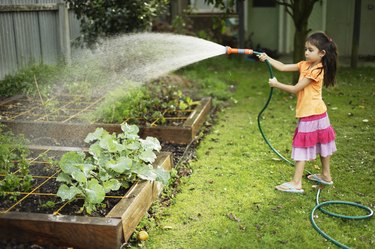
A hanging garden hose holder can save you time and effort and is well worth the expense. These holders run the gamut from simple metal to retractable ones to those that have sturdy hand cranks. Garden hose holders also help hoses last longer by preventing leaks and crimps.
Hanging Garden Hose Holder Installation
Video of the Day
Hanging garden hose holders come with mounting holes. However, the type of screws and methods you use will depend on the exterior surface of the home. Vinyl is one common kind of siding, but it can be harder to work with than other surfaces. That's because its structural support consists of studs (vertical beams that run from the ground up to the top of the structure). Even if your garden hose is lightweight, it can still pull away from the wall if you don't attach it to a stud because water is very heavy.
Video of the Day
The best way to locate studs is to use a handheld stud finder. To drill the holes, use a cordless drill with a wood bit that is 1/16 inches larger than the screw you'll be using. Then, assemble the hanging garden hose reel according to the manufacturer's instructions. Mount the holder to the siding and tighten all the bolts.
Hanging Holders on Brick or Stucco
If you're thinking about hanging a garden hose holder from brick or stucco, it may not be as difficult as you think. You just need the right kind of drill and drill bit. If you use a hammer drill, it can bore holes in minutes. Brick clips and brick hangers may also work to hang things on brick walls. However, you might wish to drill into the mortar instead since it is less likely to damage the brick and is easier to repair.

For stucco walls, mark the wall using a pencil and level. Then, mark the installation holes with a marker and drill through with a concrete or masonry drill bit. Go in no more than 1 to 1 1/2 inches. Blow out the accumulated dust inside the holes with a can of compressed air and then caulk the holes with acrylic or polyurethane caulk.
Using metal wall anchors provides the best hold. Tap those in with a hammer until they are flush with the wall. Next, screw the screws into the anchors and tighten them until they are snug. Now, you should be able to put up your garden hose hanger.
Types of Garden Hose Reels
Many homeowners have retractable hose reels, which reel up the hose on their own with a tug or a push of a button. These only accommodate up to 65 inches of hose on average, though, and have four bolts/screws. Simple hose hangers require rolling and usually have two mounting holes.

The best-known type of hanging garden hose reel is the standard model that has easy-to-use hand cranks. In most cases, they have four mounting holes, which makes them sturdy. These reels can support a lot of weight, so be sure to choose the correct fasteners.